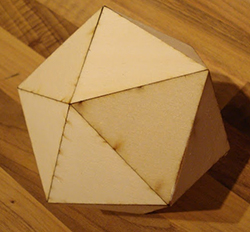 Every project deserves its own laser cut enclosure, of course, but the most common method of joinery – an overabundance of mortises and tenons, and if you’re lucky, a bit of kerf bending – is a little unsightly. Until tastes in industrial design change to accommodate this simple but primitive method of joining two laser cut panels together at an angle takes hold, the search will continue for a better way to cut acrylic and plywood on a laser cutter. The folks at Just Add Sharks might have a solution to this problem, though: miter joints with a laser cutter.
Every project deserves its own laser cut enclosure, of course, but the most common method of joinery – an overabundance of mortises and tenons, and if you’re lucky, a bit of kerf bending – is a little unsightly. Until tastes in industrial design change to accommodate this simple but primitive method of joining two laser cut panels together at an angle takes hold, the search will continue for a better way to cut acrylic and plywood on a laser cutter. The folks at Just Add Sharks might have a solution to this problem, though: miter joints with a laser cutter.
Instead of the slots and tabs of the usual method of constructing laser cut enclosures, miter joints produce a nearly seamless method of joining two perpendicular panels. The key, of course, is cutting a 45° bevel at the joint and gluing or fastening the pieces together. Just Add Sharks is doing this with a laser cut jig that holds a plywood or acrylic piece at a 45° angle to the laser beam. Yes, it’s only one cut per pass, but after adjusting the depth of cut to 1.4 times the thickness of the material, miter joints are easy.
Using a laser for miter joints isn’t limited to 45°, either. There are a few examples of an octahedron and icosahedron. Of course fastening these mitered panels together will be a challenge, but that’s what clamps and glue are for.















I can’t wait until people discover fasteners.
Requires drilling with either a cordless drill or a drill press.
Besides, LASER cutter, man….
Any holes you need to drill could be laser cut instead.. just saying.
Or these:
http://makezine.com/2013/01/25/cnc-joinery-notebook-update-1/
and
http://www.flexiblestream.org/project/50-digital-wood-joints
“Of course fastening these mitered panels together will be a challenge, but that’s what clamps and glue are for” – ever tried clamping diagonal pieces of wood? Guess what happens :) In my experience anyway; they collapse.
Why not laser cut a jig?
Using a jig should help. That and patience with the glue so you don’t glue the piece to the jig.
Just use a RaspberryPi controlling some arduino-based server controllers, then you wont need patience and 3D print the glue. All outsourced to China using that sweet Kickstarter money you just tweeted about of course.
I’m sure a snarky unrelated remark sticks better than glue. Try that next time you’re about to write a related post. Smear onto fingers and stick into mouth – let cure for at least 24 hours.
Blue masking tape is your friend
Now we just need a laser powered biscuit jointer…
If it’s wood, I think a joiner would do a better job, quicker.
Why not modify the machine to have an axis of rotation for the laser so they can cut angles?
Because modifying the path of the beam is far more complicated than changing the angle of the material. Trust me we are working on it though :)